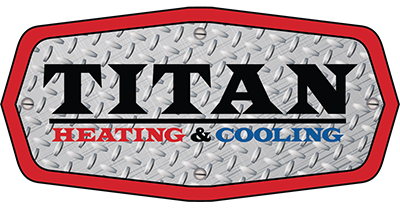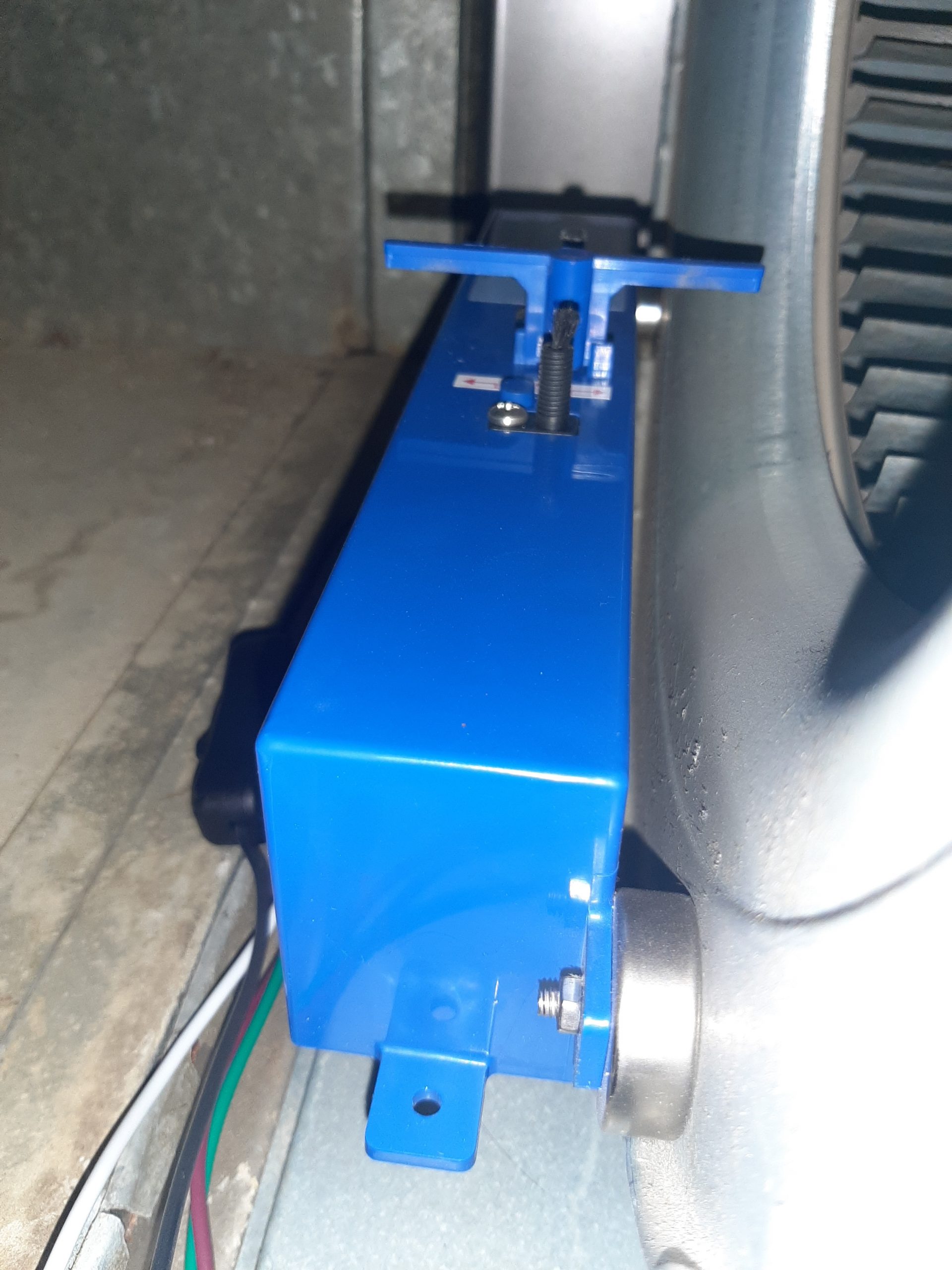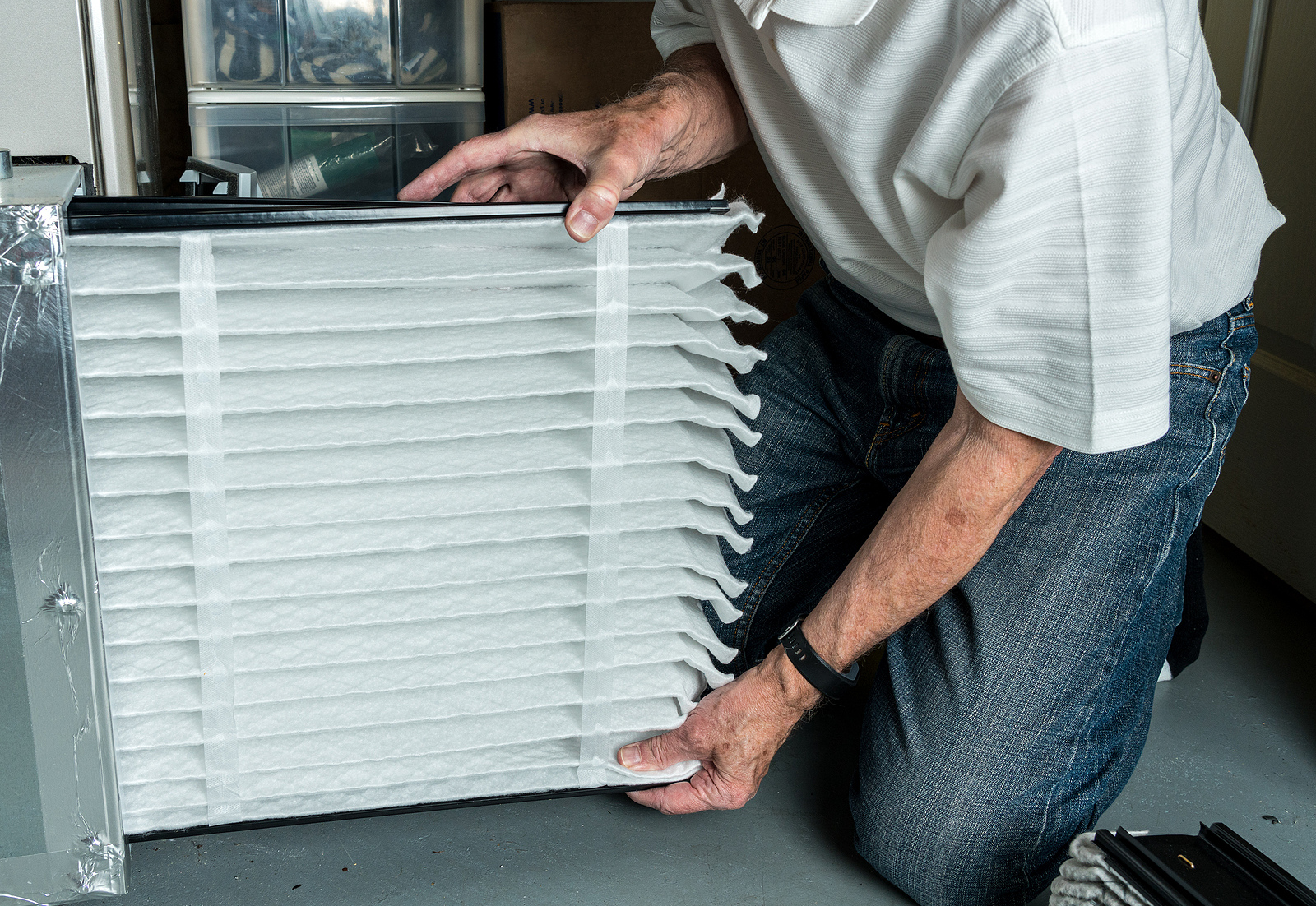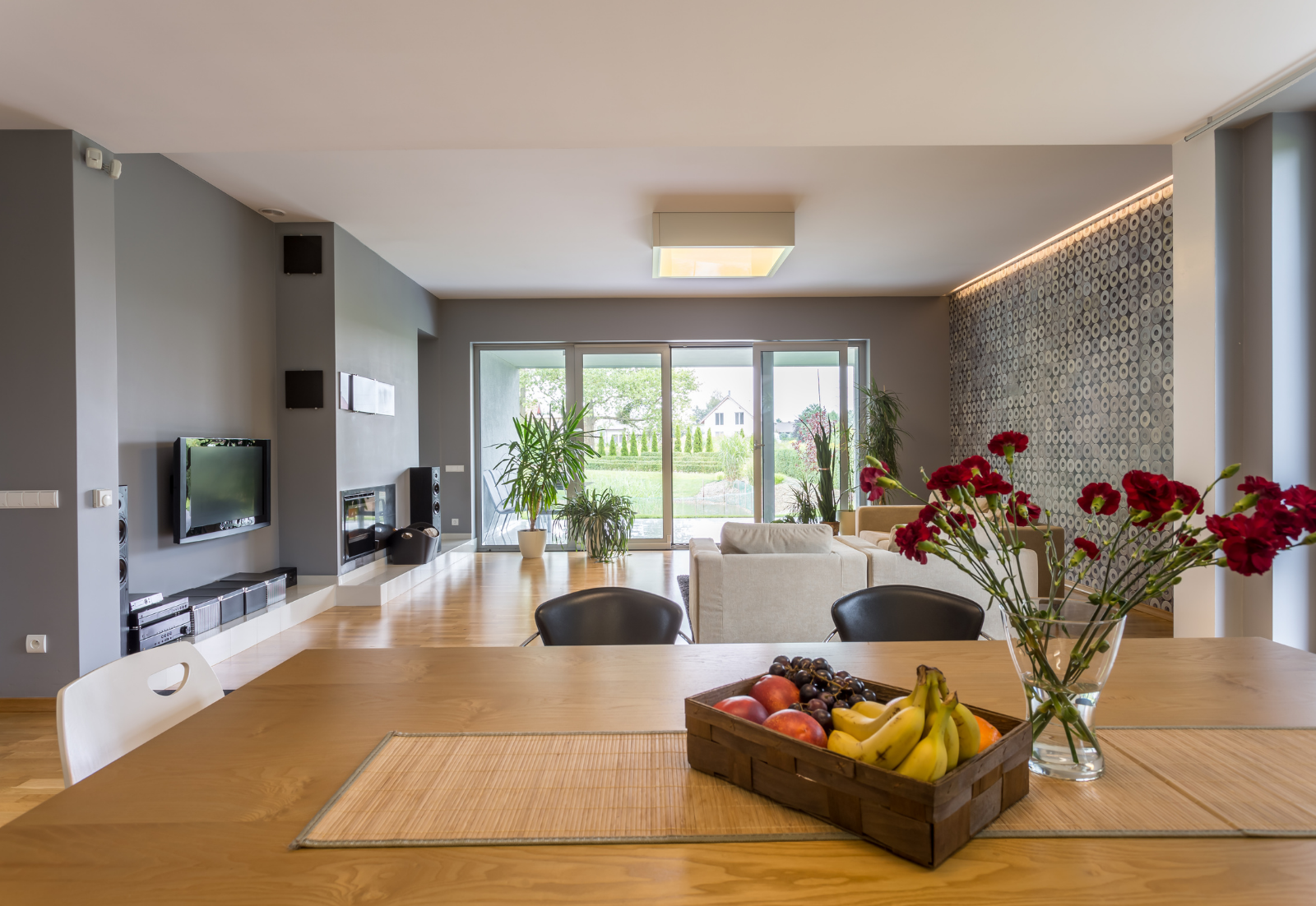Believe it or not, summer is right around the corner. Sunshine, blue skies, and warm weather are just weeks away! As exciting as that is, once it starts to warm up out there, you’ll want to make sure your air conditioning unit is ready to keep your home cool and comfortable. Take a few steps now to make sure your air conditioner is in tip top shape so that when those warm temperatures hit, you can simply flip the switch for cooler indoor air. Follow these 9 steps before turning on your air conditioner this year. 1. Inspect Air Vents and Ductwork Move items that are on or near air vents that could block the flow of air, such as furniture or drapes. Take a peek inside the grate to check for any items that have fallen through. Lift up the grate to remove items if needed. Check exposed ductwork for wear and tear. A few common issues to look for are: Gaps between duct sectionsFallen duct sectionsDisconnected jointsTears in flexible duct sections Seal up any problem areas, and contact a professional to make the necessary repairs. Worn ducts can be a major source of cooling loss and system inefficiency, leading to less efficient cooling, higher energy bills, and future air conditioning repairs. 2. Change Air Filter Your HVAC air filter traps contaminants that your system removes from the air as it runs. Once your filter becomes too full, it can no longer trap these contaminants, and excess dust and debris settle within your HVAC system. This in turn contributes to malfunctions or even breakdowns. To prevent this and maintain good air flow throughout your system, your air filter should be changed every 2-3 months or so. You should change the filter more often if you have indoor pets or family members with asthma or allergies. It’s a good idea to get in the habit of checking your air filter every month and changing it when it appears clogged. 3. Check Drain Line Your system should have a drain by the indoor cooling coil (often mounted above the furnace). The drain line can become clogged with dirt buildup as the system runs. If that happens, water could back up in the drain pan, potentially resulting in water damage to your home. You can flush the drain using bleach and water (one cup of bleach to one gallon of water), or have a professional clean it out for you. 4. Upgrade Your Thermostat If your thermostat is outdated, consider installing a new programmable or smart thermostat to save both energy and money. Replacing an old, inefficient thermostat with a new one can result in more even temperature regulation throughout your home. A new programmable or smart thermostat will be more efficient and better able to respond to changes in outdoor temperatures. 5. Inspect the Outdoor Condenser Unit Check the panels that encase your unit’s electrical connections, and call for repair if any are missing or misaligned. Harsh winter weather and storms with high winds can damage these panels or knock them loose. Running your air conditioner with missing or damaged panels can pose a major safety risk. 6. Clear Away Debris and Trim Landscaping Around Exterior Unit Leaves, twigs, grass clippings, or other debris can block the components of your outdoor A/C unit, resulting in reduced performance. Clean the area surrounding the unit, removing any blockages. Use a light spray of water to rinse away built-up dirt, pollen, and grime. Keeping your air conditioner and the area around it clean and free of obstacles will help promote good air flow and maximum cooling efficiency. 7. Check Insulation on Refrigerant Lines Your outdoor unit has coolant lines that run to...
Read MoreWe recently began offering an exciting new product here at Titan—a bipolar ionization system by Global Plasma Solutions (GPS). This system removes pathogens (including COVID-19) from the air using your existing HVAC system. It has become an important part of health protection protocols in thousands of offices, airports, hospitals, schools, and other community spaces worldwide, and now you can have this system installed in your home as well! How the GPS Bipolar Ionization System Works GPS uses a patented technology called needlepoint bipolar ionization (or NPBI™) to purify indoor air by reducing airborne particulates, odors, and pathogens. To accomplish this, NPBI™ creates and releases ions into the airstream using an existing HVAC system. These ions disperse throughout the home, forming bonds with particles in the air through a process called agglomeration. This process forms large clusters of particles that are more easily filtered out of the air by your HVAC system. In addition, the ions themselves have a microbicidal effect on pathogens, rendering them inactive. Even better, NPBI™ technology accomplishes this without producing ozone or other harmful byproducts, so it’s safe to use in your home. (Please note the disclaimers on GPS’s website stating that this technology is not intended to take the place of other precautions to prevent disease transmission, and that compliance with health authorities and CDC guidance is still important.) A New Way to Clean the Air in Your Home Since NPBI™ technology uses your existing HVAC system, it can be easily implemented in your home. Even beyond preventing the spread of infectious diseases like COVID-19, creating cleaner, safer indoor air will always be a part of maintaining a healthy home. In the past, homeowners often relied on UV lights to address their indoor air quality concerns. And UV lights can certainly be effective against bacteria, viruses, and other pathogens in the air. However, those systems require their bulbs to be replaced yearly, and those costs can add up. The GPS Bipolar Ionization System achieves the same effect as UV lights without parts that need to be cleaned or replaced. This means cleaner air with fewer ongoing costs for you. The Benefits of Using a GPS Bipolar Ionization System in Your Home Having cleaner air to breathe is a significant benefit in and of itself, but NPBI™ technology can do even more. The GPS bipolar ionization system can: Trap bacteria and viruses, helping to prevent the spread of germs.Trap dust and dust mites.Trap pet dander, mold spores, and other allergens.Reduce odor-causing Volatile Organic Compounds (VOCs). These things are especially beneficial to those who suffer from allergies, asthma, or other respiratory problems. In fact, if you are someone who suffers from one or more of these health issues, a bipolar ionization system could prove to be an indispensable part of maintaining your health. If you have pets or smokers living in your home, you likely understand how difficult it is to manage odors and keep your indoor air fresh. And even if you don’t, cooking, garbage, smoke from a fireplace, and more can quickly fill your home with unwanted odors that are difficult to remove. With a NPBI™ system, the struggle for fresh indoor air could be a thing of the past. Imagine having clean, fresh air throughout your home without the air fresheners, cleaners, and other products typically needed to remove smoke and odors! Titan Brings GPS Bipolar Ionization to You Here at Titan we have installed GPS’s NPBI™ technology in local schools and universities over the past several months, as they work to create safer indoor air for students during the pandemic. We have installed many NPBI™ systems in homes throughout our service area, as homeowners are beginning to take advantage...
Read MoreFebruary is all about love, so it’s a great time to think about how you can show your HVAC system a little love! While your HVAC system won’t appreciate flowers or chocolates (save those for your loved ones), there are a few things you can do to give it the attention it deserves. If you take good care of your heating system, it will reciprocate by keeping you cozy all winter long. Change Your Air Filter The most important thing you can do for your heating system is to change the air filter regularly. A clean filter allows air to flow freely throughout your HVAC system. As your system runs, the filter collects debris, pollutants, and other particles from the air that flows through it. When the filter becomes too full of contaminants, it can cause your system to struggle, resulting in: Higher energy billsOverworked componentsUneven heating throughout your home Make sure to change out your filter at least every 60-90 days. During months when your system is running more often, or if you have pets or family members who suffer from allergies or asthma, you will want to replace it monthly. It’s a good idea to get in the habit of checking your air filter every month. If it’s looking good, you can let it go another month. If not, it’s time to change it out. Check to Make Sure Vents Are Unobstructed Each month when you check your air filter, take a walk through your home to check your vents as well. Make sure vents aren’t blocked by furniture, clutter, or other obstructions. Blocked vents can cause uneven heating and other HVAC performance issues, resulting in higher energy bills and potentially costly repairs. Your HVAC system is made to move air, and when the vents are blocked it can’t do its job. If you can access them, don’t forget to check vents that lead outside the home as well. As it runs, your heating system produces carbon monoxide(CO). CO is typically vented outside where it’s safe to release, but if the vents are blocked it can build up inside your home. Because CO can be toxic at high levels, it’s a good idea to both check your outside vents regularly and install CO detectors throughout your home. Schedule Regular Professional Maintenance Even with regular air filter changes, your HVAC system can get bogged down with dust, dirt, and grime. This can reduce your system’s efficiency and increase your energy bills. Having your air ducts cleaned regularly is the best way to keep that from happening. In addition, treating your HVAC system to regular tuneups will help keep it healthy and running efficiently. Routinely inspecting the various components of your system can help identify potential issues before they become big (and expensive) problems. Ideally, you should have a tuneup done on your heating and cooling systems twice a year. Air duct cleanings and regular tuneups should both be handled by a professional. Show Your HVAC System a Little Love this Winter With a Maintenance Plan From Titan Here at Titan, we know that a well-maintained system can bring you lower energy bills, fewer serious repairs, and peace of mind. That’s why we recommend taking advantage of one of our HVAC maintenance plans. Our plans offer you priority service, meaning you’ll jump to the front of the line when your system needs service. You’ll also enjoy discounts on parts, labor, and installation. And with our Titan Plus HVAC maintenance plan, you’ll have scheduled maintenance each spring and fall on your heating and/or cooling system. Learn more about our maintenance plans here, and don’t hesitate to contact us at 651-714-8931 with any questions or to schedule...
Read MoreWhile indoor air quality has always been important, up until recently it isn’t something many of us thought about on a regular basis. The COVID-19 pandemic has brought the quality of the air in our homes and workplaces to the forefront of our minds as we work to make our indoor spaces as safe and healthy as possible. You may not realize this, but according to the EPA, the air inside a home or business can be 2-5 times more polluted than the air outside! Indoor air can be polluted with a variety of different things, including mold, bacteria, and viruses. But luckily there is something you can do about that: Installing an HVAC air purifier can significantly improve the quality of the air in your home or workplace. Let’s take a closer look at how an HVAC air purifier does this. HVAC Air Purifier vs Paper Filters—What’s the Difference? Ordinary paper filters found in most HVAC systems do a great job of removing dust from the air, but many of them stop there. Your indoor air can still be full of other tiny particles that can be harmful to your health. Air purification systems, on the other hand, do much more. In addition to removing dust from the air, HVAC air purifiers can also remove volatile organic compounds (VOCs), mold, bacteria, and viruses (including COVID) that circulate throughout your space, leaving your air significantly cleaner than with a traditional paper filter. Benefits of an HVAC Air Purifier Having cleaner air to breathe is a benefit in and of itself, but there are several specific ways that an HVAC air purifier can benefit you: Trapping allergens such as pet dander and mold.Trapping dust mites and dust.Removing VOCs from the air.Neutralizing smoke and odors from cigarette smoke, your fireplace, cooking, garbage, and more.Trapping bacteria and viruses, helping to prevent the spread of germs. These things can benefit anyone, but if you suffer from allergies, asthma, chronic respiratory problems, or other breathing-related health issues, an air purifier could prove to be an indispensable part of maintaining your health. Who Should Consider an HVAC Air Purifier? An HVAC air purifier can benefit anyone who wants to create cleaner air in their home or workplace. But in some cases installing an air purifier is imperative to maintaining a healthy indoor environment. For example, any business that uses VOCs, cleaning chemicals, or printers—including salons, print shops, dry cleaners, auto repair shops, and furniture refinishers—should consider an air purifier to keep the air free of toxins. And for those who regularly use a fireplace, those who live with a smoker, and those suffer from allergies or other respiratory troubles despite their best efforts to maintain a clean, dust-free home, an HVAC air purifier would be a worthy investment toward better respiratory health. Types of HVAC Air Filtration & Air Purifier Systems There are several types of HVAC air purifiers on the market, and they don’t all provide the same function. A few of the more common air purifiers are: HEPA filters can trap more than 99 percent of airborne particles that are .3 microns or larger. But HEPA filters don’t work for every system, so depending on your system this type of purifier may not be an option for you.Carbon-activated filters have absorbent pores that trap contaminants as they pass through, and work well to remove VOCs, smoke, and odors.HVAC ultraviolet light air purifiers are often used alongside HEPA filters, and use rays of ultraviolet light to kill tiny microorganisms like bacteria.Electrostatic air purifiers use static electricity to clean the air. Air flows through a network of static-prone fibers to create an electrostatic charge, which traps airborne particles.Ionizing air...
Read MoreOver the past month here at Titan, we have begun installing a new product that is helping schools and universities maintain the health safety of their students and staff during the pandemic. A new air-cleaning technology from Global Plasma Solutions (GPS) removes pathogens (including COVID-19) from the air using the existing HVAC system in a building. Let’s go over how it works. How it Works GPS’ patented technology is called needlepoint bipolar ionization (or NPBI™). This technology purifies indoor air by reducing airborne particulates, odors, and pathogens. To accomplish this, NPBI™ creates and releases ions into the airstream using your existing HVAC system. These ions disperse throughout the room and form bonds with particles in the air through a process called agglomeration. This process forms large clusters of particles that are more easily filtered out of the air by your HVAC system. In addition, the ions themselves have a microbicidal effect (meaning they destroy microbes) on pathogens, rendering them inactive. NPBI™ does this without producing ozone or other harmful byproducts, so it’s safe to use in indoor spaces. You can see how this technology could change the game this winter for schools, universities, and other businesses that rely on gathering people indoors. Please note that in their disclaimers, GPS states that this technology is not intended to take the place of other precautions to prevent the transmission of disease, and that compliance with health authorities and the CDC’s guidance is still important, including but not limited to social distancing, hand hygiene, cough etiquette, and the use of face masks. Testing and Compliance This technology has undergone several rounds of testing to prove its safety and effectiveness. GPS has done in-lab sensitivity testing and simulations, as well as field testing in several of their customer locations, and has found it to be effective and non-harming both to people and the environment. As a bonus, it has also been shown to save up to 30% on energy consumption! This technology has been registered and certified by UL 867 and UL 2998 as ozone-free, and is CE compliant. Where it’s Being Used NPBI™ is already being used in thousands of offices, airports, hospitals, schools, and other community spaces worldwide. Among their list of customers, GPS lists Harvard University, Google, Boston Children’s Hospital, and even the White House. Titan has only been installing this product for the past month, but already it is in high demand among our customers, especially local school districts. The hope is that this technology will help schools stay open during the pandemic, while providing an added level of safety for students, teachers, and staff. This exciting new technology is available for installation by our HVAC technicians here at Titan. If NPBI™ sounds like a good fit for your building, or if you have questions, call us at 651-714-8931. ...
Read MoreGenerally speaking, large open spaces take more energy to heat and cool than smaller enclosed spaces, especially if they have high or vaulted ceilings. Yet modern open floor plan design tends to result in greater energy efficiency, not less. Let’s take a look at why that is. More Natural Light Homes with an open floor plan have fewer walls and angles to block the spread of light, allowing you to take full advantage of natural lighting. Sunshine can stream throughout the space uninhibited, filling your home with natural light. More natural light equates to more natural warmth as well, decreasing your reliance on your furnace in the winter. During the summer, improved airflow helps maintain more consistently cool temperatures, and shades and ceiling fans can help keep things cool so you don’t overtax your A/C unit. If windows are optimally placed in the home so that you can get the most benefit from natural light, you will reduce the amount of energy you need to heat and light your home. Improved Air Circulation Walls impede the flow of air, making enclosed spaces stuffy. They also make it difficult to maintain consistent temperatures throughout the home — often, one room will feel just right while the rest are too warm or too cold. You can overwork your HVAC unit trying to keep all of your rooms comfortable. An open floor plan allows air to circulate freely, making it easier to keep indoor air fresh and maintain an even temperature throughout the home while reducing the energy you use. Less Square Footage Needed The same square footage can feel bigger or smaller depending on the design of the home. Homes with open floor plans feel more spacious than those with a traditional floor plan, meaning you need less square footage to create an open and spacious atmosphere in your home. In other words, a smaller home with an open floor plan can feel just as spacious as a larger home with a traditional layout. The smaller your home, the less energy it requires to heat, cool, and light, and the lower your utility bills are. Open floor plans are not without their downsides — less privacy, potentially noisier, difficult to contain kitchen odors, and so on — so they are not to everyone’s preference. But when it comes to energy efficiency, modern open floor plan design has traditional floor plans beat.Whether you have an open floor plan or a traditional home, the best way to keep your HVAC unit running as efficiently as possible is with a routine maintenance plan. Contact Titan to get on our calendar for routine maintenance, repair, or replacement by giving us a call at 651-714-8931. We look forward to serving you! ...
Read MoreFall is officially here, which means heating season is just around the corner. But before you turn on your furnace for the first time, there are a few things you should do to ensure it’s ready to keep your home warm all winter long. Change the Air Filter A clogged air filter keeps your furnace from running efficiently and can potentially cause it to overheat. Check your filter monthly and change it as needed — at least every 3 months, but more often if you have allergies or pets who shed. If you have a reusable air filter, vacuum it to remove any dust, then wash it with soap and water and allow it to dry before inserting it back into the furnace. Uncover Vents & Clear Out Debris Blocked vents will keep heat from flowing uniformly throughout your house, so make sure nothing is obstructing your heating vents — including furniture, curtains, rugs, or other objects. You can also remove the register covers and vacuum out the ducts with a hose attachment to remove some of the dust and debris that accumulates between regular professional cleanings. Declutter the Area Around Your Furnace Items stored near your furnace can pose a fire hazard. Move anything that is stored close to your furnace unit, paying special attention to flammable items such as rags, mops, paper, and chemicals. To be on the safe side, it’s best to keep all flammable materials in a separate room from the furnace. Test Smoke and Carbon Monoxide Detectors Test your smoke and carbon monoxide (CO) detectors to ensure they are in working order, and change the batteries if you haven’t done so in a while. If your home doesn’t have CO detectors, you’ll want to add them. When a furnace burns oil or natural gas to create heat, carbon monoxide is produced as a by-product. The CO is typically vented out of your home by your heating system, but cracks in the heat exchanger, blockages in the vents, or other issues can cause your furnace to leak carbon monoxide, putting your family at risk for CO poisoning. Carbon monoxide detectors typically last 5-7 years, so if yours is on the older side, it may be time to replace it. Test the Thermostat Test your thermostat to make sure it’s communicating with your furnace. Turn the thermostat up high enough to make the heat kick on, and if it seems like it's not communicating with the furnace, replace the batteries (if it has batteries). If that doesn’t fix the problem, you may need a new thermostat. Seal Doors and Windows Make sure all outside doors and windows have a nice tight seal. Any gaps will allow heated air to escape and cold air to enter your home, making your furnace work even harder to keep your house at a consistent temperature (and therefore increasing your heating bill). Schedule an Inspection Routine yearly maintenance helps keep your furnace in tip top shape as well as reduce the cost of major repairs. Fall is the time to schedule a tuneup and inspection for your furnace to make sure it’s ready for the cold weather months. During an inspection an HVAC technician will inspect your system for signs of wear and tear, clean out your system, and make any needed adjustments to keep everything running reliably throughout the winter. And if your furnace is nearing the end of its life, this is a good time to have it checked out to see if it can hang on for another year or if it’s time for a replacement. Titan Heating & Cooling is here to help you with regular HVAC maintenance, new furnace installation, or any...
Read MoreJust like your car, your HVAC system needs routine preventative maintenance to keep it running at its best. HVAC repairs can be costly, but luckily there are a few simple things you can do each month to keep your system in shape and avoid unnecessary repairs. These three tasks are at the top of our list for routine HVAC maintenance. 1 - Change the Air Filter Operating your HVAC unit with a dirty or clogged filter can cause damage to your equipment and reduce your indoor air quality. Your air filter needs to be changed every 30-90 days and checked for dirt and clogs every month. To check it, remove the air filter and look for damage. If there is damage, or if you haven’t changed the filter in a while, swap it out for a new one. If there is no damage and you want to extend the filter’s life for another month, gently wipe off any dirt with a damp cloth. The more people and pets you have in your home, the more often you will need to change your filter. When buying new filters, look for a high MERV rating, which is a measure of energy efficiency. If you have allergies, consider a HEPA filter to improve your air quality even more. 2 - Check Drains and Hoses Take a look at your A/C unit’s drains and hoses each month, looking for obstructions and leaks. Inspect the drain pans and condensate drains, ensuring they are unobstructed and clean. This will keep excess moisture from being trapped in the unit or inside the house. 3 - Clean the Outside Unit Cleaning the outside unit of your HVAC system is just as important as tending to the indoor unit. Each month, check to make sure your outdoor unit is free of leaves, twigs, or other debris, and that trees or shrubs offer at least 2-3 feet of clearance around the unit. Remove the fan cage on top of the unit and vacuum out the interior. Use a gentle spray from your garden hose to clean dust off of the fins, and wipe down the outside of the unit as well. Doing these three things each month, along with routine annual maintenance, will help keep your HVAC system in prime condition, so you can stay cool in the summer and warm in the winter. If you are in need of HVAC maintenance or service, Titan Heating and Cooling has your back — give us a call at 651.714.8931. ...
Read MoreWhen we consider the quality of the air we breathe, we tend to think of outdoor air pollution, but we don’t often think about pollution in the air inside our homes. But in many cases, indoor air can be just as polluted, if not more so, than the air outside. Poor indoor air quality can cause or contribute to an array of health problems - some minor, others much more serious. Let’s take a look at how the air you breathe could be impacting your health. What Causes Poor Indoor Air Quality? Many things can cause the air in your home to become polluted: Dust Mold Mildew Smoke from cigarettes or cooking Fumes from carpet and furniture Bacteria or viruses Pet dander Cleaning products Air fresheners and more can all diminish the quality of the air you breathe. All of your day-to-day activities ultimately contribute in one way or another to the air quality in your home. Additionally, improper ventilation and high humidity can increase the concentration of pollutants in the air, further contributing to the problem. Health Effects Associated With Poor Air Quality The effects of exposure to poor indoor air quality vary depending on many factors, including the type and concentration of pollution in the air, the sensitivity level of each person, and the length of exposure to the pollutant. If you have symptoms at home but they diminish or disappear when you leave, it’s possible you are experiencing the effects of poor air quality. Some of the health effects that polluted indoor air contributes to are: Immediate effects: Irritation of the eyes, nose, throat, or skin Headaches Dizziness Fatigue Shortness of breath or mild asthma Long-Term Effects: Respiratory disease Rapid heartbeat or heart disease Nausea or vomiting Worsening asthma symptoms Lung cancer These long-term effects can happen in cases where you are exposed to particularly harmful pollutants (such as radon or ozone) or to a high concentration of less harmful pollutants for an extended period of time, and you may not notice more severe symptoms for many years. Also, some people are more sensitive to pollutants than others, so all family members may not experience the same symptoms. How to Improve Indoor Air Quality There are a number of ways to improve the quality of the air in your home, ranging from simple things you can try on your own to bigger changes that require help from a professional. Opening up the windows for ventilation, opting for cleaning and personal care products that produce less toxic fumes, running a dehumidifier on humid days, changing your air filter regularly, and having your HVAC system professionally cleaned can significantly improve your indoor air quality. For an even greater improvement in your home’s air quality, consider installing a whole-house ventilation system or adding an air purifier to an existing system. Product Spotlight: BreatheCLEAN Air Purifier Here at Titan we recommend the BreatheCLEAN Total Home Air Purifier for the ultimate in indoor air purification. BreatheCLEAN uses the power of pure ultraviolet light to kill airborne microorganisms such as germs, bacteria and mold. It easily installs into the existing ductwork of your home’s central ventilation system and continually cleans the air as it circulates. No competing model offers more effective purification for your home, and the BreatheCLEAN system costs less than you’d think. If you’re ready to improve the quality of your indoor air with an air purifier, upgraded air filter, new dehumidifier, or professional HVAC cleaning, Titan Heating & Cooling has what you need. Give us a call at 651.714.8931 or contact us here. ...
Read More











